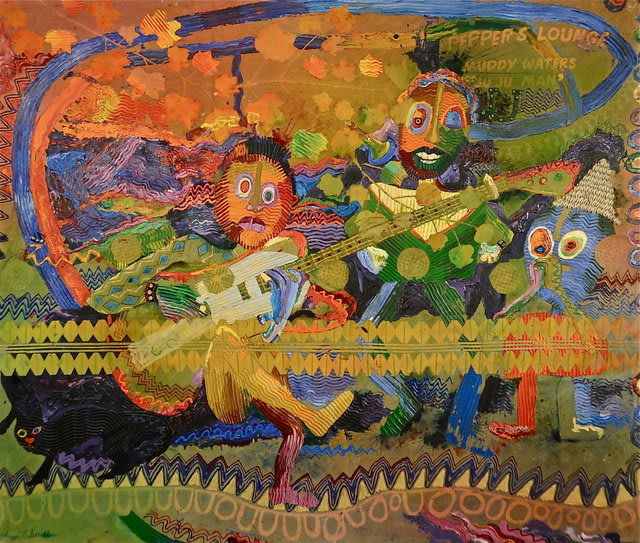
Wadsworth Jarrell
Juju Man from the Delta, 1985
acrylic on canvas
68 x 90 in (172.7 x 228.6 cm)
In this 1985 painting, JuJu Man from the Delta, Jarrell captures Mississippi blues man Muddy Waters, the famous harmonica player Little Walter and Earl Hooker, all playing at Pepper’s Lounge...
In this 1985 painting, JuJu Man from the Delta, Jarrell captures Mississippi blues man Muddy Waters, the famous harmonica player Little Walter and Earl Hooker, all playing at Pepper’s Lounge in Chicago. The artist was interested in portraying these Southern Delta musicians, who brought their genre of music to Chicago. With poetic simplicity, Jarrell represents both Waters and Walter by their instruments. This painting tells the story of this moment and the musicians. Though the location of the scene is Chicago, the painting is peppered with voodoo elements brought up from the South: good luck black wrist bands are found on the musicians’ wrist, a black cat, and the horseshoe pattern are all direct references. In the lower half of the painting, Jarrell wraps the canvas with a strip of cowrie shells. Used for money and rituals in Africa and Asia, the shells add additional layers of culture references and tradition. Jarrell also uses abstract African symbols and design patterns in an undulating application of repetitive triangles, chevrons, and leaf images across the front of the canvas, and the fluid way the leaf pattern weaves in between figures. Through syncretism of African Fon/Vodum water deities and Mississippi Delta voodoo, Jarrell is manipulating cultural images into spiritual icons.
Physically, Jarrell uses various tools beyond the paint brush to create JuJu Man from the Delta. He creates the vibrant and textured painting by using non-traditional “brushes”, such as cardboard or a brick layer’s trowel. The result is a rich painting thick with tactility and presence.
Physically, Jarrell uses various tools beyond the paint brush to create JuJu Man from the Delta. He creates the vibrant and textured painting by using non-traditional “brushes”, such as cardboard or a brick layer’s trowel. The result is a rich painting thick with tactility and presence.
